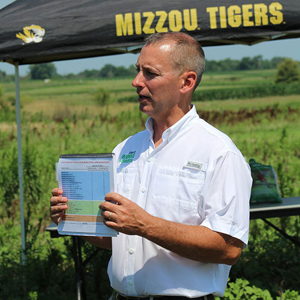The Environmental Protection Agency wants to hear from state pesticide regulators about any issues they experience with use of dicamba in the coming growing season.
“I really want to try to coordinate with them,” Dan Kenney, head of the herbicide branch in the Office of Pesticide Programs’ registration division, said on the sidelines of the annual meeting of the Association of American Pesticide Control Officials. In particular, Kenney said he wants to know what’s happening in the fields and if regulators are having any trouble interpreting EPA label requirements.
If the last two years are any indication, Kenney will be getting some phone calls. In 2017, complaints about damage from the herbicide — Bayer’s Xtendimax, DuPont’s (and now Corteva Agriscience’s) FeXapan, and BASF’s Engenia — covered about 3.6 million acres, according to reports summarized by University of Missouri weed scientist Kevin Bradley.
Last year the acreage number was down to about 1.1 million acres, but Bradley’s last report — published July 15 — covered a shorter time period and fewer states. Soybean growers planted RoundUp Ready 2 Xtend seeds on about 45 percent of soybean acres last year.

Kevin Bradley, University of Missouri
In many states, however, the damage has not been just to off-site targets but to the credibility of pesticide regulators. Tim Creger, pesticide/fertilizer program manager in the Nebraska Department of Agriculture, said the number of dicamba complaints in 2017 and 2018 stretched his staff too thin to handle just about anything else.
“It has made my program a one-issue program,” he told attendees at the meeting Tuesday. “That’s all I’ve done for two years. I don’t have the time to dedicate to other problems.”
The initial damage came in 2017, when his office had to tell some complainants that a lack of personnel meant their fields wouldn’t be checked. “We had to tell people after the first week of July — we may not be able to respond to your complaint,” Creger said.
In October, EPA updated label requirements for the three dicamba formulations, adding additional restrictions on application timing and buffer sizes, among other changes. But enforcing application standards — like wind speeds above or below which spraying can occur — is more difficult than enforcing recordkeeping violations, Creger said.
Ambiguous or unclear label language for dicamba highlights the need to address label language problems more broadly, regulators said.
“This has to be the most scrutinized label in the history of the agency,” said Leo Reed, pesticide licensing manager in the Office of the Indiana State Chemist. “Yet we are finding amazingly poorly written label language.”
One example, cited in a guidance document being prepared by a workgroup of the State FIFRA Issues Research Group, calls label language for Engenia misleading because it sounds like it is requiring applicators to determine the potential risk to downwind sensitive crops and residential areas before spraying. In fact, the language was meant to be advisory, the SFIREG document, which has not been finalized, says.
The label does, however, prohibit application when wind is blowing in the direction of sensitive crops or residential areas.
Reed said state regulators have been complaining about “meaningless” label language, such as “Do not apply when drift is likely to occur,” for decades.
“That exists on many product labels,” Reed said. “It’s a darn shame that we’re still grappling with issues of that magnitude.”
For more news, go to www.Agri-Pulse.com


